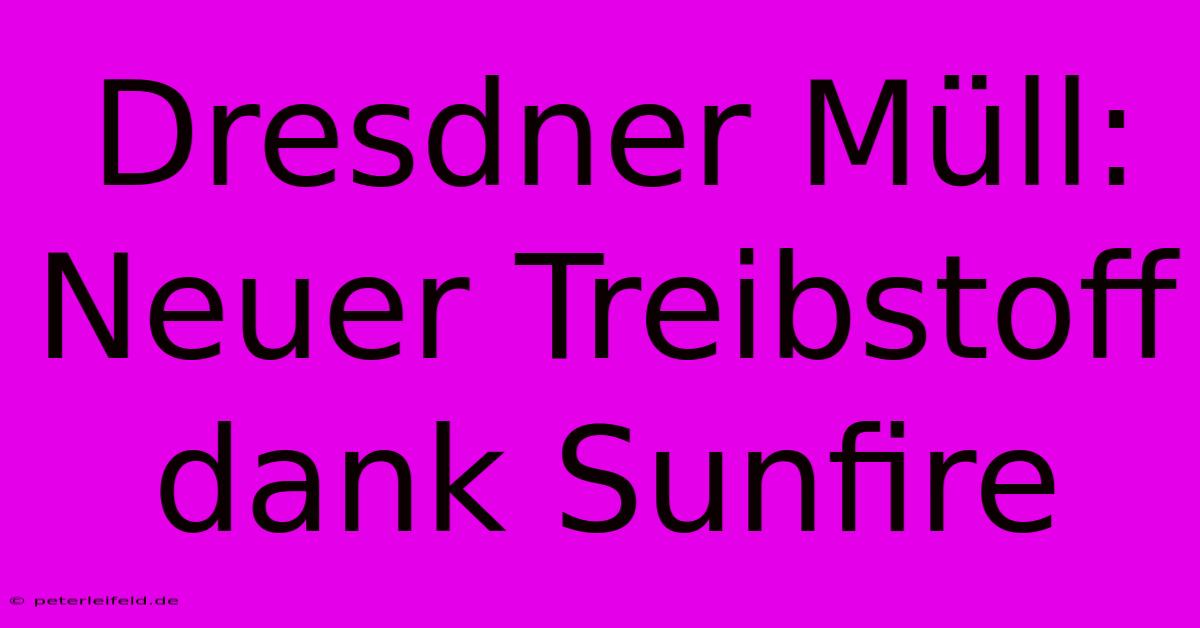Dresdner Müll: Neuer Treibstoff Dank Sunfire

Discover more detailed and exciting information on our website. Click the link below to start your adventure: Visit Best Website Dresdner Müll: Neuer Treibstoff Dank Sunfire. Don't miss out!
Table of Contents
Dresdner Müll: Neuer Treibstoff dank Sunfire – Eine grüne Revolution?
Hey Leute, let's talk trash – or rather, Dresdner Müll and how it's getting a seriously cool upgrade thanks to Sunfire. I mean, who'd have thought our old garbage could become rocket fuel? Okay, maybe not rocket fuel, but something pretty darn close. This whole thing blew my mind, so I'm diving in headfirst to share what I've learned.
From Trash to Treasure: Sunfire's Power Play
So, I'm a bit of a recycling nerd – always been fascinated by the whole waste management process. I even tried to build a compost bin once. It didn't go well. Let's just say the neighborhood squirrels had a field day. Anyway, the Sunfire project in Dresden is next-level stuff. They're taking municipal solid waste – that's your everyday garbage – and turning it into synthetic fuels using their power-to-X technology. Pretty wild, right?
Think about it: all that stuff we throw away – plastic bottles, food scraps, newspapers – is getting a second life as renewable fuels. That's a HUGE step towards a greener future, especially when you consider the environmental impact of traditional fossil fuels.
The Science Bit (Don't Worry, It's Not That Scary!)
Now, I'm no scientist, but basically, Sunfire uses electrolysis to split water into hydrogen and oxygen. Then, they use the hydrogen to make synthetic methane – which is basically natural gas – using CO2 captured from the waste incineration process. It's a closed-loop system, meaning they're reducing CO2 emissions while creating a valuable energy source.
I initially struggled to grasp all the technical details; it felt overwhelming. But breaking down the process into smaller, simpler steps helped. You can find tons of Sunfire power-to-X info online if you want the full technical rundown, but the core idea is pretty straightforward.
The Dresdner Müll Factor: A Local Impact
This project isn't just some far-off, theoretical experiment; it's happening right here in Dresden. And that's what makes it so exciting! It directly addresses the challenge of waste management in the city, reducing landfill burden and creating a valuable energy resource. It’s a win-win situation.
I recently saw a documentary about Dresden and its waste management strategies. I was so impressed by how proactively the city is working towards sustainability. Sunfire’s initiative is a huge piece of that puzzle.
Challenges and Opportunities
Of course, there are challenges. Scaling up a project like this is never easy, there will always be unexpected hurdles. Costs are certainly a major factor, but so is public acceptance. Some people might be wary of synthetic fuels, having concerns about their long-term effects. That's why transparent communication and clear information about the environmental benefits are crucial.
The Bigger Picture: A Sustainable Future?
The Sunfire project in Dresden is more than just a local initiative; it’s a potential game-changer for how we deal with waste and energy production. It offers a sustainable alternative to fossil fuels, showcasing how innovation can address both environmental concerns and economic needs. It’s a hopeful sign that we’re moving towards a future where we can turn our trash into treasure – literally!
The long-term potential is enormous. Imagine other cities adopting this technology – a huge reduction in global CO2 emissions, increased energy independence, and a cleaner environment. It's a vision worth fighting for.
So, yeah – Dresdner Müll might sound kinda gross, but thanks to Sunfire, it’s becoming a powerful symbol of innovative, sustainable solutions. Pretty cool, huh? Let me know what you think in the comments below! And if you have any questions, ask away! I did tons of research on this. I’m still learning, but I’m totally hooked on this topic now.

Thank you for visiting our website wich cover about Dresdner Müll: Neuer Treibstoff Dank Sunfire. We hope the information provided has been useful to you. Feel free to contact us if you have any questions or need further assistance. See you next time and dont miss to bookmark.
Featured Posts
-
Hyundai Aktie Schlechte Aussichten
Nov 22, 2024
-
Boning Linz Besuch Wortwitz Badehose
Nov 22, 2024
-
Usa Bondi Trumps Neue Person
Nov 22, 2024
-
Teenie Dubai Knast Sex 17 Jahre Alt
Nov 22, 2024
-
Kaminofenverbot 2010 Ausnahmen Filterpflicht
Nov 22, 2024
